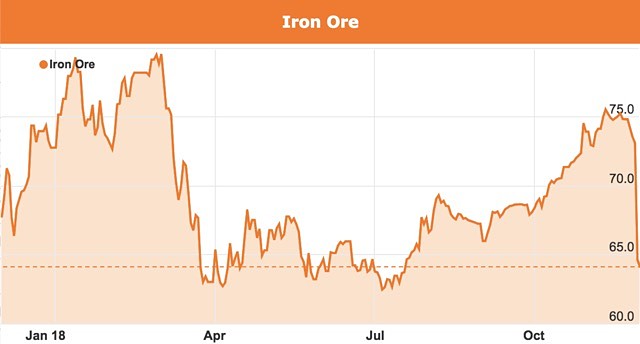Australian iron ore under pressure as demand for steel weakens

Softening iron ore and steel prices could be signs of an economic slowdown ahead.
Of all of the concerns caused by a raft falling prices for bonds, shares and commodities over the past five weeks, one that is particularly troublesome for Australia is the plummeting price of iron ore.
And not just any iron ore but particularly the price of higher grade iron ore, which is the predominant product we export in massive quantities out of the Pilbara in Western Australia.
Indeed, iron ore is Australia’s biggest export, ahead of coal, petroleum products including gas and gold.
The fact that higher grade iron ore is falling even faster than the price of lower grade ore points to a couple of troubling trends.
Is Chinese steel heading for a glut?
One is that there is increasing speculation that Chinese steel production is heading for a glut as global and regional demand stalls.
Falling steel prices have limited demand by Chinese steel mills for high grade iron ore which has had the effect of greatly narrowing the premium higher grade iron ore has over benchmark ore.
Speculation over less severe steel production cuts in China in the months ahead is helping to bolster demand for lower and mid-tier iron ore grades at the expense of higher quality ore.
This time of year is traditionally a period of weak steel demand in China but steel output from the mills has remained strong, raising concerns about the potential of a steel glut in the months ahead.
This concern has not just been reflected in lower iron ore spot prices but in the spot prices of other steelmaking ingredients such as coking coal and coke.
Does falling demand signal slowing growth?
The second trend is that falling steel prices could also be pointing to a slow-down in Chinese growth and to a broader slowdown of global growth.
The trade war between the US and China has brought the Chinese economy into sharp focus and has already exposed concerns about slowing growth, of which the potential steel glut could be just one symptom.
Much of the crunch in world share and commodity markets over the past seven or eight weeks has centred around the potential for global growth to slow as the large economies including the US, Europe and China feel the effect of rising interest rates and global trade tensions, including US tariffs.
Australia could already be slowing
Falling prices for Australia’s high quality iron ore could not have come at a worse time for us.
While on paper Australia’s economy is still growing at a healthy annual pace of more than four per cent, there are several signs that things may have taken a turn for the worse since the first half of the year.
According to ANZ Bank’s September Stateometer released this week, most states and territories are now growing below average levels with economic activity continuing to decelerate.
ANZ blames the downturn in the housing market, and in the process throws some shade on the Reserve Bank’s forecasts that growth will continue above three per cent over the next couple of years.
“The loss of momentum demonstrated by the Stateometer is consistent with our forecast that the Australian economy will grow at a year-ended pace of 2.9 per cent by the June quarter 2019, down from 3.4 per cent in June this year,” said ANZ economists and report authors Cherelle Murphy and Jack Chambers.
“This slowing brings into doubt the 3.25 per cent year-end growth rate forecast by the Reserve Bank for the June quarter 2019,” they said.
The loss of momentum is consistent with ANZ Research’s forecast for the Australian economy to grow 2.9 per cent, down from 3.4 per cent in the previous corresponding period.
Mining exports key to growth
What is particularly troubling about this report is that trade in general and mining exports in particular are the key areas of continuing growth.
While every Australian state except Tasmania experienced a drag to momentum from the housing component of the index, trade was a highlight.
The mining states of Western Australia and Queensland recorded stronger positive contributions as resource prices, export volumes and the $A/$US exchange rate moved in their favour.
Trade momentum continues
In New South Wales and Victoria, which are less commodity intensive but have large service sectors, trade momentum also picked up, suggesting a further boost to tourism and education exports.
The report cited consumer and business confidence, higher building approvals in some commercial segments, an upbeat outlook for private business investment and a solid pipeline of public sector infrastructure as key positives.
However, the tightening of credit market conditions remained a negative factor that together with a poorer outlook for house prices is pulling back demand, particularly in New South Wales and Victoria.
“Momentum slowed further in the September quarter across most of Australia,” said the report.
“All states and territories except Tasmania and the Northern Territory decelerated and recorded growth at below their trend rates.”
A key test on how the Australian economy is performing will be the release of Australia’s third quarter GDP report on Wednesday, December 5.

